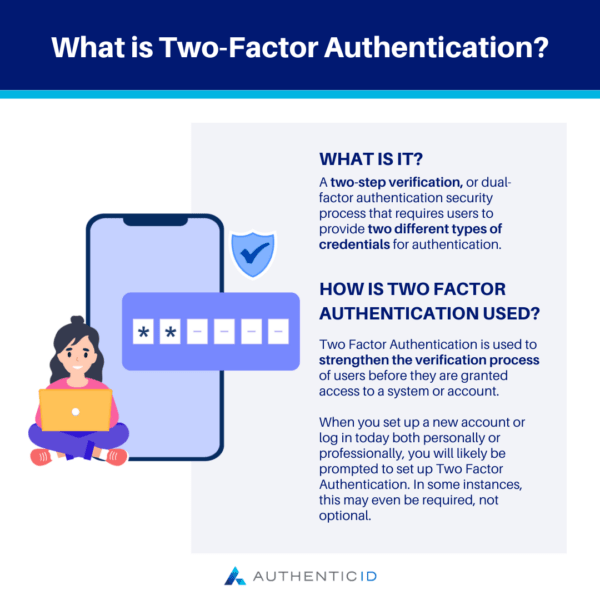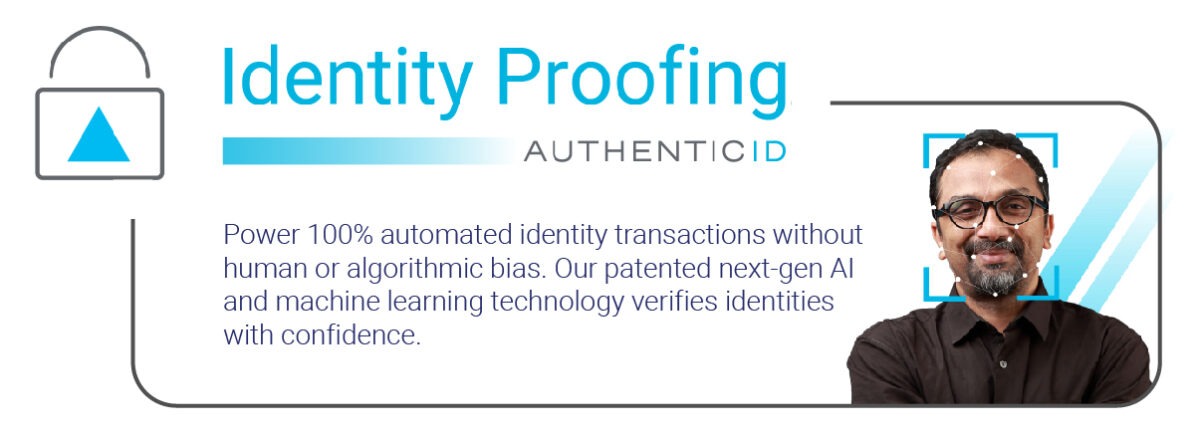Two Factor Authentication, also known as 2FA, is a two-step verification, or dual-factor authentication security process that requires users to provide two different types of credentials for authentication. Two Factor Authentication is designed to provide an additional layer of validation than methods that use one (namely a password). This authentication method relies on the user providing a password and a second factory, either a biometric scan or security token.
Two Factor Authentication
Two Factor Authentication requires authorized users to provide two unique forms of validation before they can be granted access to a system.
This authentication process is more secure than requiring just a password to verify someone’s identity and is now commonly used to access online accounts and smartphones, among other uses.
What is Two Factor Authentication?
Two Factor Authentication, commonly referred to as 2FA, is a two-step verification, or dual-factor authentication security process that requires users to provide two different types of credentials for authentication.
Two Factor Authentication is designed to provide an additional layer of validation than methods that use just one (like a password).
This authentication method relies on the user providing a username, password, and then a second factor, either a biometric scan or a security token.

How is Two Factor Authentication Used?
Two Factor Authentication is used to strengthen the verification process of users before they are granted access to a system or account.
When you set up a new account or log in today both personally or professionally, you will likely be prompted to set up Two Factor Authentication. In some instances, this may even be required, not optional.
In this case, you will set up a password as normal, then be required to set up a second factor depending on the 2FA system the program utilizes. Then on subsequent log-in attempts you will need to correctly provide your password and username, then the second factor that the system requires.
The second factor that you set up in the system is not an alternative should you forget your initial password; rather, you will need to correctly provide both factors together in order to gain access to your account.
What are Authentication Factors?
An authentication factor is a unique identifier that a user provides that can serve as verification of their identity.
Security professionals today recognize up to five different authentication types that can be used to verify users’ identities, including:
• Knowledge Factors: something that the user knows that is private to them (a password)
• Possession Factors: something unique that the user possesses (a security key/push notification/etc.)
• Inherence Factors: a biometric trait that is unique to the user (fingerprints/retina/face/etc.)
• Location Factors: the exact location of a user in the world (IP address)
• Time Factors: the time of a user’s log-in attempt compared to the time of historical attempts
With Two Factor Authentication, then, the system can require any two of the abovementioned factors in order to authenticate users’ authorization attempts. Most commonly, 2FA systems rely on a combination of knowledge factors, possession factors, and inherence factors.
Benefits of Two Factor Authentication
Even though logging in to an account when Two Factor Authentication is set up can take longer, most experts recommend the use of this security feature wherever you can because of the security benefits it provides.
Continue reading below as we further explore the benefits of Two Factor Authentication.
1) Extra Security
The primary benefit of Two Factor Authentication is that it provides an added layer of security to keep unauthorized users from accessing accounts or systems with just a stolen or compromised password.
Data breaches can be costly, so 2FA helps to protect against phishing attempts, brute-force attacks, social engineering, and other unauthorized log-in attempts aimed at acquiring sensitive data or information in your possession.
2) Simple to Use & Convenient
Another great feature of Two Factor Authentication is the fact that it is very easy to set up and to use on a regular basis. Plus, it is typically implemented using devices and accounts you already have readily on hand, like a cell phone or an email account.
The technology behind Two Factor Authentication and how it verifies your identity may be sophisticated, though the front-end, user-facing side is quite intuitive.
This means that users with essentially any level of knowledge of technology or cyber security can take advantage of 2FA without running into issues or needing to acquire additional devices.
3) Speed
Even though logging in to an account when 2FA is set up takes longer than a standard log-in process with just a username and a password, it is quite quick when considering how much it strengthens the security of your accounts.
Two Factor Authentication’s fast user journey iis part of the reason why it has become so commonly used today.
4) Scalable
Two Factor Authentication is a security feature that can easily be scaled for systems that need to provide security to thousands of accounts, or even millions in some cases.
So, both small and large organizations can take advantage of the security advantages that 2FA provides.

Common Use Cases of Two Factor Authentication
Two Factor authentication has grown in popularity in recent years and now is commonly implemented across a number of different industries and sectors.
Let’s take a look at some of the common ways that 2FA is utilized today:
• Healthcare – Healthcare organizations must meet a number of compliance regulations to protect patient data and information, while still allowing physicians and healthcare providers to access patient data as needed; 2FA helps ensure only authorized users are allowed to access such information and keep it protected from bad actors
• Financial Services – The banking industry relies on 2FA to protect internal systems and users’ accounts by authenticating each login attempt to prevent hacking that is done for financial gain
• Social Media – Social media platforms utilize 2FA to protect the sensitive information and personal data of billions of users around the world from hacking attempts
• Government – Efforts to modernize government agencies for the digital age and move to the cloud have created unique security challenges; 2FA helps federal agencies retain strong levels of security for their systems, though still allowing millions of end users to access their data/accounts as needed
• Education – Educational institutions at all levels can utilize 2FA to ensure that private and sensitive information on students and staff can only be accessed by authorized users within online web portals
